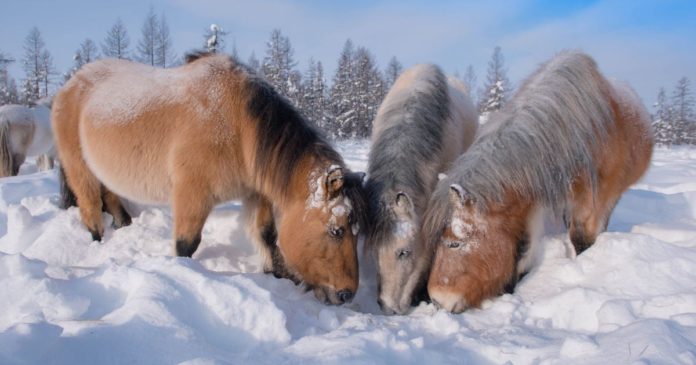UNVEILING THE YAKUTIAN HORSE’S SURVIVAL SECRETS 🐴


The Evolutionary Marvel and Cultural Pillar: Unveiling the Yakutian Horse’s Survival Secrets
In the frigid realms of Siberia, where temperatures plummet to chilling depths, a remarkable equine breed thrives—the Yakutian horse. Native to the Sakha Republic in Russia, these resilient steeds possess an extraordinary ability to endure and flourish in one of the world’s most extreme environments.
Centuries ago, the Yakut people migrated to Siberia, bringing their horses along. Facing the harsh realities of the frozen wilderness, these horses underwent a rapid evolutionary transformation to adapt to the bone-chilling cold. In just 800 years, these sturdy equines developed incredible physiological changes that helped them survive temperatures as low as -70°C (−94 °F).

Credits: Picture: Maria
The Yakutian horses boast distinguishing features that highlight their adaptation to the unforgiving climate. Their compact stature, standing at an average of 13 to 13.3 hands high, helps them retain body heat more effectively. Their dense mane and tail, along with an exceptionally thick winter coat, shield them from the biting cold.
Adaptation isn’t just skin deep for these horses. Their ability to gain extra fat—up to 35 kilograms—during Siberia’s short summer months allows them to endure the harsh winter by losing up to 20% of their total weight. With acute senses and sturdy hooves, they forage for sparse fodder buried beneath the snow, employing their hardiness and resilience to survive the challenging landscape.

Credits: Picture: Maria
But it’s not merely physical traits that define these horses. For the Yakut people, these resilient steeds were far more than just beasts of burden. They served as transportation, providers of milk and meat, and sources of spiritual connection in the shamanic Yakutian culture. Revered for their wild spirit, these horses were domesticated just enough to fulfill their various roles while retaining their independence.

Credits: Picture: Maria Vasilyeva
While modern life has reduced the Yakut people’s reliance on these horses for survival, the Yakutian horse remains a symbol of cultural heritage and spiritual significance. Festivals, ceremonies, and daily life still celebrate the enduring spirit of these remarkable creatures.
Yakutian Horses: Siberia’s Resilient Survivors
By
19

The Evolutionary Marvel and Cultural Pillar: Unveiling the Yakutian Horse’s Survival Secrets
In the frigid realms of Siberia, where temperatures plummet to chilling depths, a remarkable equine breed thrives—the Yakutian horse. Native to the Sakha Republic in Russia, these resilient steeds possess an extraordinary ability to endure and flourish in one of the world’s most extreme environments.
Centuries ago, the Yakut people migrated to Siberia, bringing their horses along. Facing the harsh realities of the frozen wilderness, these horses underwent a rapid evolutionary transformation to adapt to the bone-chilling cold. In just 800 years, these sturdy equines developed incredible physiological changes that helped them survive temperatures as low as -70°C (−94 °F).

Credits: Picture: Maria Vasilyeva
The Yakutian horses boast distinguishing features that highlight their adaptation to the unforgiving climate. Their compact stature, standing at an average of 13 to 13.3 hands high, helps them retain body heat more effectively. Their dense mane and tail, along with an exceptionally thick winter coat, shield them from the biting cold.
Read also : 5 Most Calm Horse Breeds
Adaptation isn’t just skin deep for these horses. Their ability to gain extra fat—up to 35 kilograms—during Siberia’s short summer months allows them to endure the harsh winter by losing up to 20% of their total weight. With acute senses and sturdy hooves, they forage for sparse fodder buried beneath the snow, employing their hardiness and resilience to survive the challenging landscape.

Credits: Picture: Maria Vasilyeva
But it’s not merely physical traits that define these horses. For the Yakut people, these resilient steeds were far more than just beasts of burden. They served as transportation, providers of milk and meat, and sources of spiritual connection in the shamanic Yakutian culture. Revered for their wild spirit, these horses were domesticated just enough to fulfill their various roles while retaining their independence.

Credits: Picture: Maria Vasilyeva
While modern life has reduced the Yakut people’s reliance on these horses for survival, the Yakutian horse remains a symbol of cultural heritage and spiritual significance. Festivals, ceremonies, and daily life still celebrate the enduring spirit of these remarkable creatures.
Similar : https://bestuneed.com/2023/11/28/american-paint-horse-chronicles-5-intriguing-facts-unveiled/
Despite challenges such as decreasing equine populations, the Yakutian horse endures as a testament to the resilience and adaptability of both nature and human-animal partnerships. Their legacy persists, reminding us of the incredible evolutionary journey that has shaped these resilient steeds, allowing them to thrive in the unforgiving landscapes of Siberia.













